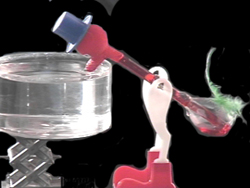It was a bird that only a mother could love, with its blue top hat; red felt face and beak; big white eyes; clear glass tube neck; white shapely hips and legs; bright red feet; and a light green feather attached to its large bulb shaped see-thru posterior containing red or blue colored liquid.

The “drinking (also dubbed ‘dunking’ or ‘dipping’) bird” was constantly rocking back and forth and periodically dipping its beak into a glass of water, seemingly by magic.
The distinctive little creature was a permanent fixture at my Grandmother Cox’s house on East Fairview Avenue in the late 1940s and 1950s. She kept it at different locations in her house. It was usually positioned in front of a full glass of water, rendering it a perpetual drinker. It added new meaning to the derogatory expression, “Go soak your head.” Anytime I came to grandma’s house, I usually found the cute little imbibing bird busy at work performing its usual repetitive chore.
Occasionally, I found it motionless without its water glass. Grandma, at my insistence, would correct that situation by placing a full glass of water in front of it, bringing its head forward until its beak was submerged in water and allowing the felt portion of it to become saturated with water. She then released it, permitting the bird to immediately spring into action.
The critter would rock back and forth until it almost came to a standstill, after which it would gradually start leaning toward the glass of water. It would then “take a swig” and begin rocking again. The cycle would repeat itself about every 20-25 seconds. The bird ran nonstop as long as it could obtain a drink of water. Take away the glass or let the water level drop too low and the little bird would soon become motionless. I sat mystified for long periods of time watching it perform its ritual.
Some people became so enamored with the product that they “doubled their pleasure, doubled their fun” by purchasing a pair, letting them drink out of the same glass. Not satisfied with one or two of them, a few enthusiasts acquired several and placed them in a line or in a circle for added amusement and watched them perform out of sync. America had a love affair with the “drinking bird.”
Miles V. Sullivan is credited with being the creator of the product, patenting it in 1946. It became an instant sensation with a war-weary public and almost overnight became a common fixture in many homes.
The bird even appeared in the 1951 Warner Brothers Merrie Melodies cartoon titled, “Putty Tat Trouble.” While fleeing the advances of Sylvester the cat, Tweety Bird, a talking canary famous for uttering “I tawt I taw a puddy tat,” encounters a “drinking bird,” mistakenly thinking it is the real thing. Tweety begins emulating the bogus bird by methodically bobbing up and down in front of a glass of water.
At the risk of boring you with the scientific reason for the patented creature’s curious behavior, let me briefly explain that the educational device is actually a heat engine, containing methylene chloride liquid and vapor that operates through a thermodynamic cycle that incorporates latent heat of evaporation, temperature drop, pressure drop, vapor condensation and a shifting center of gravity.
The inexpensive drinking bird is available for sale today, but one word of caution to those inclined to purchase one. It is not a toy to be placed in the hands of young children. It is breakable and the liquid will stain anything it touches. Also, methylene chloride has some health issues.
About 1960, the always thirsty entertaining and educational “drinking bird” took flight into my yesteryear.

Comments are closed.